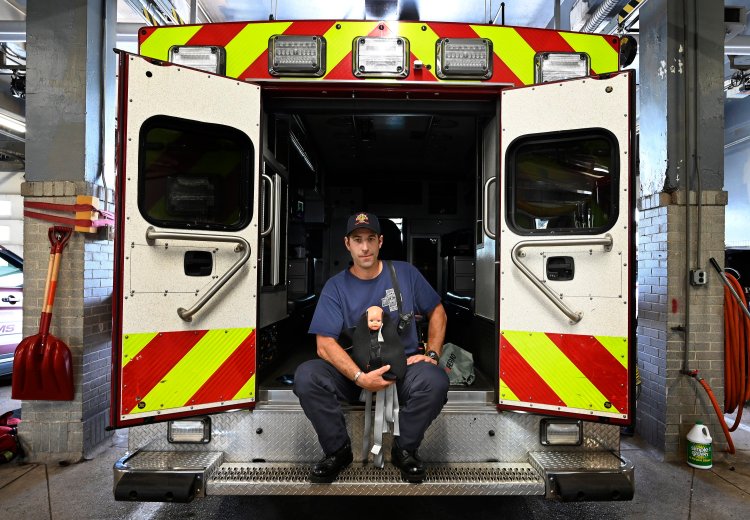
Lt. Stephen Coppi with a device called a KangooFix that he and other Portland firefighters used when they helped deliver a baby recently. The KangooFix attaches the infant to the mother securely so they can be close during the ambulance ride. Shawn Patrick Ouellette/Staff Photographer
When Lt. Stephen Coppi responds to an emergency call for a mother in labor, nerves are high.
“OB calls strike very personal with a lot of our members because they’re either moms or dads themselves,” said Coppi, a paramedic with the Portland Fire Department. “These calls can go either really awesome, or to the highest extreme intensity of health care for us, because this is a child.”
When he arrives and there are no complications, he said crews want to take their time to “be a part of someone’s family,” letting the father cut the cord and giving the parents time to bond with the baby before they’re ushered off to the hospital in separate ambulances.
Now, EMS responders in Maine can transport infants strapped to their mothers’ chests with a newly available device. Named KangooFix, it holds the baby in a pouch, strapped to the mother so the mother and child keep that connection on the way to the hospital.
Portland firefighters demonstrated last week how the device works. Paramedics swaddle the baby in a soft shell and secure it to the mother with a five-point harness. Then they secure the harness straps to the straps holding the mother in the stretcher. The outer shell, designed to keep the baby warm and dry, is made of a wet suit material. Some department workers call it a “baby Koozie.”
Lt. Stephen Coppi, right, demonstrates with paramedics Jake Cole, left, and Mike Casey how KangooFix works by attaching the harness to Devin Mill, the department’s principal financial officer. Shawn Patrick Ouellette/Staff Photographer
Dr. Rachel Williams, medical director for Maine’s EMS for Children program, said this is crucial for helping mother and child make an early connection.
“It jump starts a lot of things for the baby when they make that first connection with mom,” Williams said. “If they’re able to continue that during the transport, that’s very beneficial.”
She said skin-to-skin contact is vital to calm both the mother and baby. It regulates the baby’s heart rate, breathing and temperature, can stimulate digestion and enable bacteria transfer, which protects against infection.
Williams also said these new measures are especially helpful because if the baby is brought to the hospital before the mother in a separate ambulance, staff has no information.
“How far along were they? Was this a complicated pregnancy for any reason? Are there any maternal risk factors we need to know about?” Williams said. “If the mom has not arrived yet because her ambulance is coming second, then we wouldn’t know that.”
OXYTOCIN ALSO AVAILABLE
After a field delivery in 2023 in which the mother and newborn had to be separated, Coppi said he worked with Maine EMS to find a solution. Working with the Maine Department of Health and Human Services, they created a grant to make this device available to EMS agencies across the state.
Another new resource given to EMS providers this year is oxytocin. They’re now able to carry the drug, which helps to minimize the risk of postpartum hemorrhage, a potentially fatal condition.
Portland paramedics now have access to a device called the KangooFix, which attaches an infant to their mother securely so they can be close during their ambulance ride. Shawn Patrick Ouellette/Staff Photographer
Portland EMS Division Chief Sean Donaghue said Maine’s first EMS oxytocin delivery was at an emergency call in March, when the crew delivered a baby on scene and the mother had significant hemorrhage.
“They allowed mom and baby to bond and feed, and they really took their time on scene before we even talked about transporting,” Donaghue said. “And then they transported using (the Kangoo Fix). That was a really, really great call.”
Williams said several hospitals across the state have changed whether they receive pregnant patients, so some people have to go further to find care. These two improvements for emergency deliveries show that prenatal and obstetric care are more “on the radar” for Maine and Maine EMS, she said.
“I think that we’re doing a good job of addressing the potential complications and trying to minimize complications and improve care for these patients pre-hospital,” Williams said.
« Previous
Related Stories
Invalid username/password.
Please check your email to confirm and complete your registration.
Use the form below to reset your password. When you’ve submitted your account email, we will send an email with a reset code.